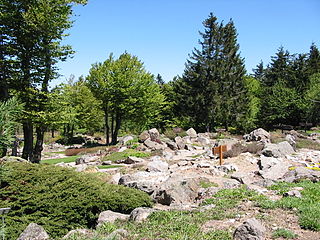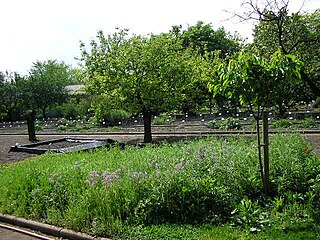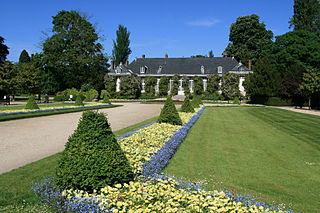The Jardin botanique de l'Hôpital d'Instruction des Armées Clermont-Tonnerre (Botanical Garden of the Teaching Hospital of the Clermont-Tonnerre Armies) is a botanical garden located on the grounds of the Hôpital d'Instruction des Armées Clermont-Tonnerre at Rue du Colonel Fonferrier, Brest, Finistère, in the region of Brittany, France. It is open to the public weekend afternoons; admission is free.
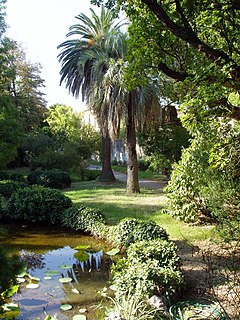
A botanical garden or botanic garden is a garden dedicated to the collection, cultivation, preservation and display of a wide range of plants labelled with their botanical names. It may contain specialist plant collections such as cacti and other succulent plants, herb gardens, plants from particular parts of the world, and so on; there may be greenhouses, shadehouses, again with special collections such as tropical plants, alpine plants, or other exotic plants. Visitor services at a botanical garden might include tours, educational displays, art exhibitions, book rooms, open-air theatrical and musical performances, and other entertainment.

Brest is a city in the Finistère département in Brittany. Located in a sheltered position not far from the western tip of the peninsula, and the western extremity of metropolitan France, Brest is an important harbour and the second French military port after Toulon. The city is located on the western edge of continental Europe. With 142,722 inhabitants in a 2007 census, Brest is at the centre of Western Brittany's largest metropolitan area, ranking third behind only Nantes and Rennes in the whole of historic Brittany, and the 19th most populous city in France; moreover, Brest provides services to the one million inhabitants of Western Brittany. Although Brest is by far the largest city in Finistère, the préfecture of the department is the much smaller Quimper.

Finistère is a department of France in the extreme west of Brittany.
The garden was begun in 1688 by Desclouzeaux, Intendant de la Marine at Brest, as a jardin des simples for herbs and medicines on the grounds of the royal naval hospital (established 1684). Under the supervision of chief gardener Antoine Laurent (1744-1820) it developed greatly to become an important adjunct to the Jardin du Roi (now Jardin des Plantes) in Paris, as Brest's mild climate favored the cultivation of a wide variety of exotic plants from around the world. By the 19th century it had become a major botanical garden, but the slow withering of its original medical function led to a progressive decline. The garden's remnants were almost totally destroyed in World War II, along with the hospital itself, but in subsequent years the garden has been gradually been restored.

Paris is the capital and most populous city of France, with an area of 105 square kilometres and an official estimated population of 2,140,526 residents as of 1 January 2019. Since the 17th century, Paris has been one of Europe's major centres of finance, diplomacy, commerce, fashion, science, and the arts.

World War II, also known as the Second World War, was a global war that lasted from 1939 to 1945. The vast majority of the world's countries—including all the great powers—eventually formed two opposing military alliances: the Allies and the Axis. A state of total war emerged, directly involving more than 100 million people from over 30 countries. The major participants threw their entire economic, industrial, and scientific capabilities behind the war effort, blurring the distinction between civilian and military resources. World War II was the deadliest conflict in human history, marked by 50 to 85 million fatalities, most of whom were civilians in the Soviet Union and China. It included massacres, the genocide of the Holocaust, strategic bombing, premeditated death from starvation and disease, and the only use of nuclear weapons in war.
Today the garden's terraces are again open to the public, and still display some 19th-century accessions. The garden is described in Actu Santé as containing the oldest two Chinese palms in Europe, the largest Ginkgo biloba in Europe, and excellent specimens of Camellias and Gunnera manicata . Rare and valuable specimens are identified by signs.
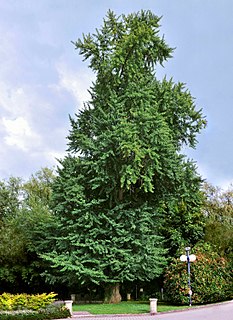
Ginkgo biloba, commonly known as ginkgo or gingko, also known as the maidenhair tree, is the only living species in the division Ginkgophyta, all others being extinct. It is found in fossils dating back 270 million years. Native to China, the tree is widely cultivated, and was cultivated early in human history. It has various uses in traditional medicine and as a source of food.
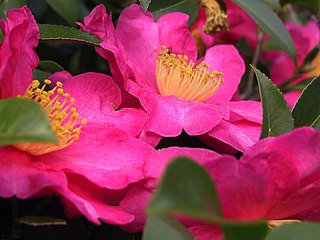
Camellia is a genus of flowering plants in the family Theaceae. They are found in eastern and southern Asia, from the Himalayas east to Japan and Indonesia. There are 100–300 described species, with some controversy over the exact number. There are also around 3,000 hybrids. The genus was named by Linnaeus after the Jesuit botanist Georg Joseph Kamel, who worked in the Philippines and described a species of camellia. Camellias are famous throughout East Asia; they are known as cháhuā in Chinese, tsubaki (椿) in Japanese, dongbaek-kkot (동백꽃) in Korean, and as hoa trà or hoa chè in Vietnamese.

Gunnera manicata, known as Brazilian giant-rhubarbgiant rhubarb, or dinosaur food, is a species of flowering plant in the Gunneraceae family from Brazil.






